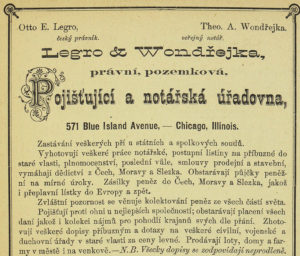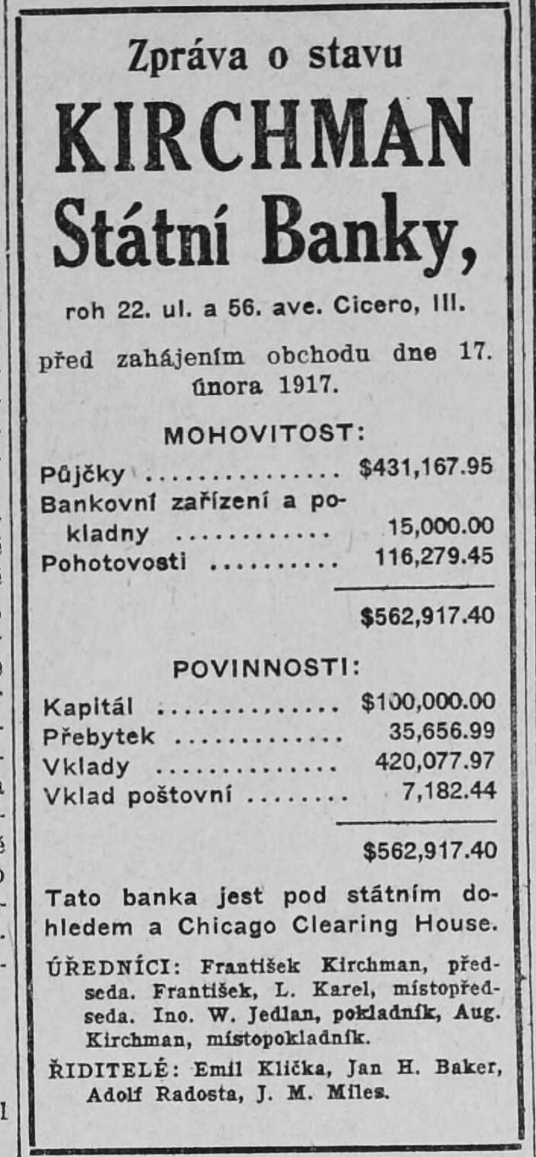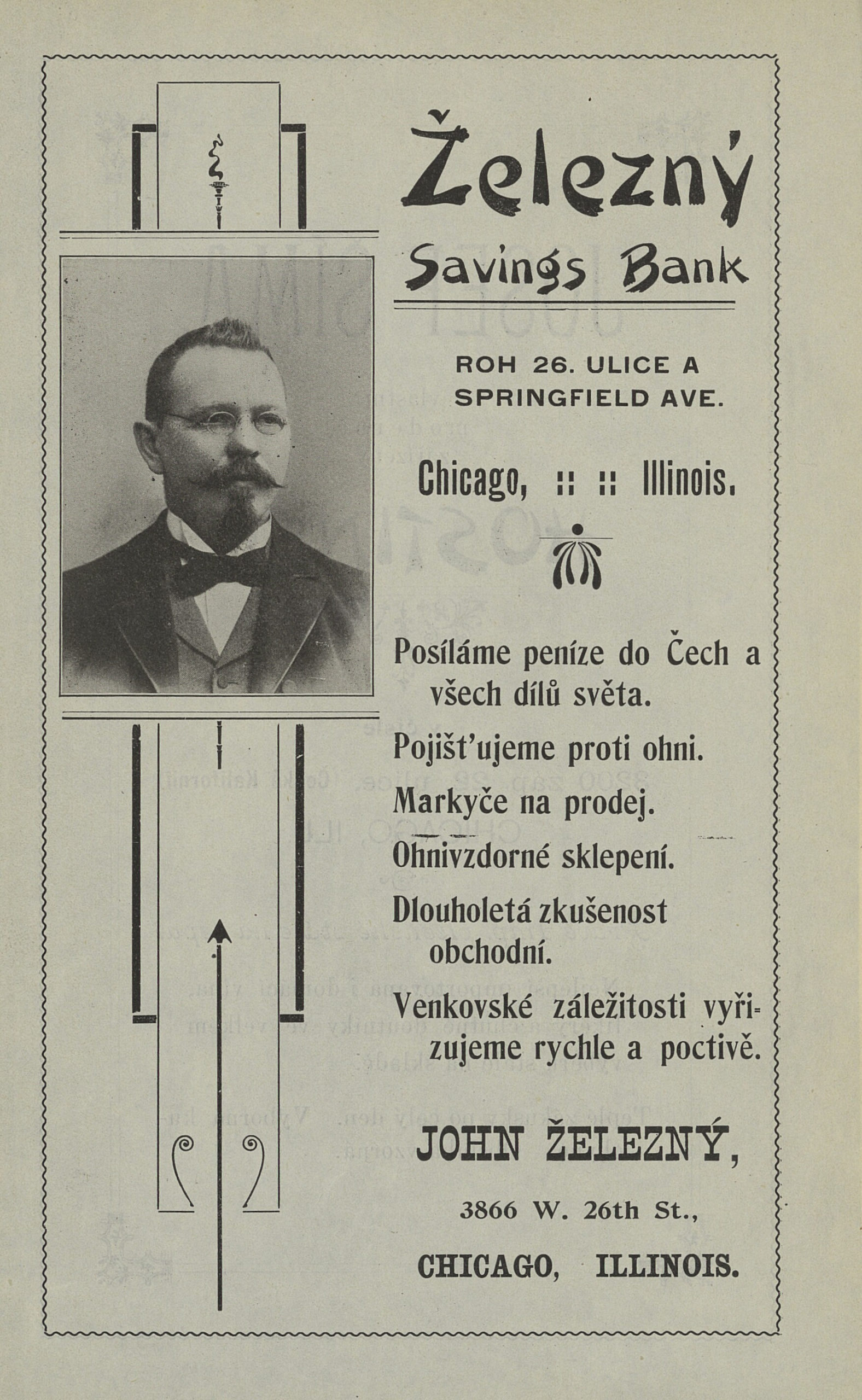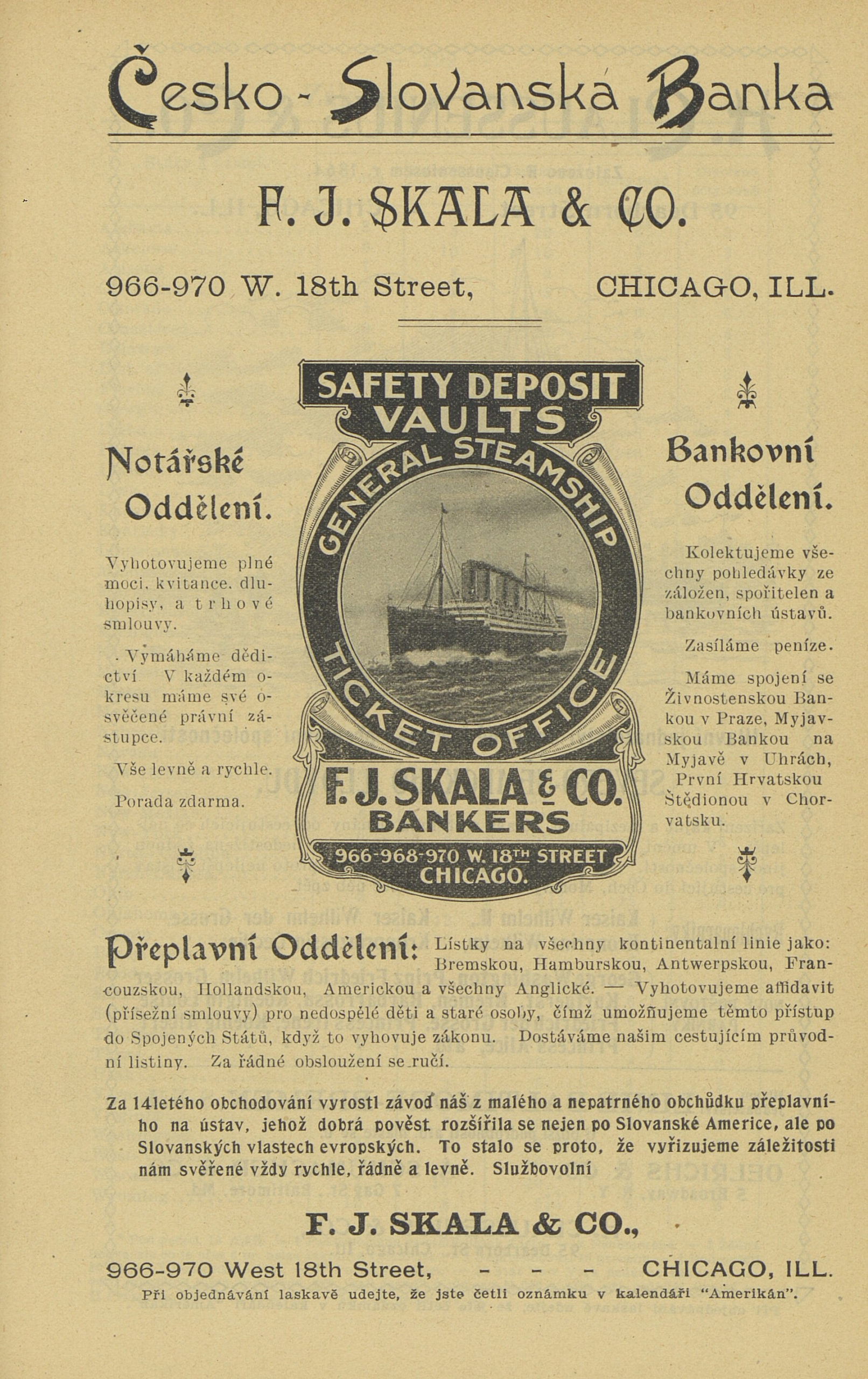Czech Banking In Chicago
Background
“In the Slavic family it was traditional for the family to support itself collectively. One innovation, the use of a carefully prepared budget became widespread. The family typically assumed the position of fiscal manager in the Slavic immigrant family and nearly always administered this carefully prepared budget. (1)
budget became widespread. The family typically assumed the position of fiscal manager in the Slavic immigrant family and nearly always administered this carefully prepared budget. (1)
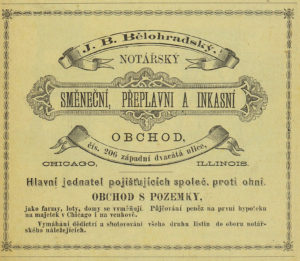 Before there were banks owned by Bohemians there were Bohemians who were notaries, insurance, real estate and steamship ticket sales businessmen, sometimes one doing all those tasks.
Before there were banks owned by Bohemians there were Bohemians who were notaries, insurance, real estate and steamship ticket sales businessmen, sometimes one doing all those tasks.
“We are told that every president of the Chicago banks has had his start in banking as a real estate broker. In time the broker, if his venture proved successful, branched out as a private banker, doing besides, notarial, insurance, real estate, and the steamship ticket business. The law requiring him to have his affairs examined from time to time by banking authorities hastened the process of evolution from private banker to that of a state or national bank.” (2) (Image Left (2a) Right (2b)
Before there were banks owned by Bohemians there were Bohemian Building and Loan Associations
Slavs in America did not find the opportunity for significant occupation mobility as earlier immigrant arrivals as the Irish and Germans already held the skilled industrial jobs. Slavs would turn to home ownership as a means of solidifying their precarious economic status. In nearly every Slavic ethnic community in America immigrant savings and loan associations were established for the purpose of issuing home mortgages.”
The first building and loan association appeared in Chicago in 1873 by socialist lawyer Prokup Hudek. A Czech immigrant in Chicago, Leo Meilbeck was the first office holder of Czech extraction to be elected to the Illinois State Legislature. Elected in 1878 (Illinois General Assembly #31, for District 3) he was successful in proposing a bill permitting the organization of the building and loan associations. (3)
On September 12, 1879, the Chicago newspaper, The Inter Ocean, published a notice that the Illinois Secretary of State had licensed the Bohemian Building, Loan and Homestead Association of Chicago.

Chicago Tribune - Chicago Building Societies Which Represent an investment of $5,000,000
The Bohemians the Pioneers
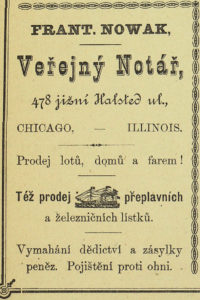 During the last nine years more than a score of building societies have been organized in Chicago. Financial disaster has not overtaken one of them, and so marked has been the success of each corporation that new societies are constantly being formed. Bohemian residents were the first to demonstrate in Chicago the practical utility of this form of provident cooperation. From William Kaspar, an intelligent and wealthy Bohemian who has lived in Chicago for twenty years, a TRIBUNE reporter yesterday obtained some statistics concerning the fifteen Bohemian building societies in Chicago. The first was organized nine years ago, and it is still in existence. Its name is “The Chicago Bohemian Building and Loan Association, No. 1.” The next society of this character was also organized by Bohemians, and is known as No.2. Its shares are limited to $250,000, and of this sum, $230,000 has been paid in. Following came No. 3, and then No. 4. The latter is probably the wealthiest of all the Bohemian societies. The societies subsequently organized dropped figures as distinguishing their identity, and adopted familiar Bohemian names. The society las organized is called “Tabor,” which is a name familiar to all Bohemians. It is four months old; its limit is $500,000, and of this amount $200,000 is already pledged.
During the last nine years more than a score of building societies have been organized in Chicago. Financial disaster has not overtaken one of them, and so marked has been the success of each corporation that new societies are constantly being formed. Bohemian residents were the first to demonstrate in Chicago the practical utility of this form of provident cooperation. From William Kaspar, an intelligent and wealthy Bohemian who has lived in Chicago for twenty years, a TRIBUNE reporter yesterday obtained some statistics concerning the fifteen Bohemian building societies in Chicago. The first was organized nine years ago, and it is still in existence. Its name is “The Chicago Bohemian Building and Loan Association, No. 1.” The next society of this character was also organized by Bohemians, and is known as No.2. Its shares are limited to $250,000, and of this sum, $230,000 has been paid in. Following came No. 3, and then No. 4. The latter is probably the wealthiest of all the Bohemian societies. The societies subsequently organized dropped figures as distinguishing their identity, and adopted familiar Bohemian names. The society las organized is called “Tabor,” which is a name familiar to all Bohemians. It is four months old; its limit is $500,000, and of this amount $200,000 is already pledged.
“What have the Bohemians done with the moneys raised in these societies?” asked the reporter of Mr. Kaspar.
“Built themselves dwelling houses”
“How many houses have they erected in all?”
“Not less than 600.”
“How much money has been invested in these societies?”
“Not less than $2,700,000.”
“And has this great fund been honestly managed?”
“I am glad and proud to say that it has,” replied Mr. Kaspar. “There are at least 35,000 Bohemians in Chicago, and all seem to be anxious to buy a little land and build a little house which they can call home. In these societies we aim to help each other; in fact, we load money only to members.”
“How do you account for the success of these societies?”
“Economical and honest management, no high salaries, every man a vigilance committee to see that no dollar is wasted, and that ample security is given for all moneys loaned. These societies are multiplying rapidly throughout the city. The Germans and Irish are organizing; there are two Polish societies, and there is at least one English society, call the Garden City Equitable Loan and Building Association. I hope they will succeed, but they must be careful. They must watch the items of expense; there must be no fancy printing, no showy offices, no high salaries, and above all the loans must be made only to men who give undoubted security. Bohemias are economical, and these societies have worked good for their members because of the economy practiced in their management.” (4)
The Loan Association and Their Pioneers - The Bohemians - Svornost, March 27, 1883 (Foreign Language Press Survey)
The Sunday's Tribune brings much information of the loan associatons founded in Chicago and prospering successfully until now. In the first lines of the correspondence the Tribune states that the Bohemians are pioneers in these associations and writes verbatim:
"In the last nine years there were founded in Chicago more than twenty loan associations. None of them was struck by any misfortune or disaster, and the continuity of the success of these associations is so well known that new ones are still being organized.
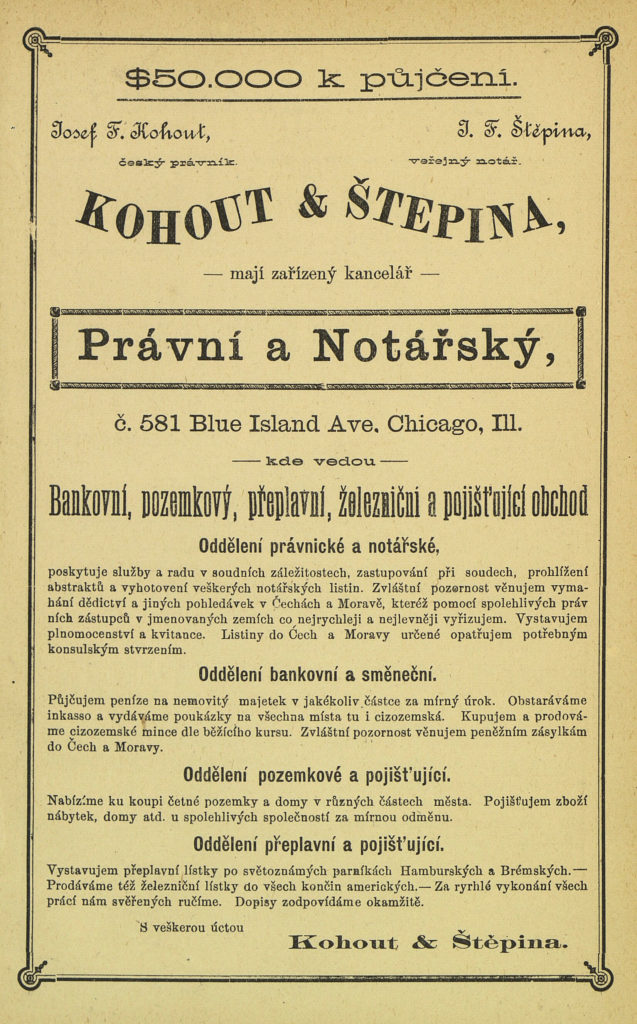 The Bohemian citizens in Chicago are the first to prove the usefulness of this mutual aid and cooperation. One of the Tribune's reporters was yesterday informed by Vaclav Kaspan, an intelligent and well to do Bohemian who has been living in Chicgo over twenty years, that there are in our city fifteen "Bohemian Loan Associations." The first of these associations was founded nine years ago and exists until now under the name "The Chicago Bohemian Building and Loan Association, No. 1."
The Bohemian citizens in Chicago are the first to prove the usefulness of this mutual aid and cooperation. One of the Tribune's reporters was yesterday informed by Vaclav Kaspan, an intelligent and well to do Bohemian who has been living in Chicgo over twenty years, that there are in our city fifteen "Bohemian Loan Associations." The first of these associations was founded nine years ago and exists until now under the name "The Chicago Bohemian Building and Loan Association, No. 1."
Its capital amounted to $250,000, however, there were sold shares for only $150,000. All the shares were redeemed and the first series put on the market four years ago. The second series is right now in progress and represents a capital of $250,000. This will be redeemed in eight months. The second association of the same kind was founded by the Bohemians and denominated with No. 2. Its shares are limited to $250,000, and of this amount $230,000 is already redeemed. After this, followed the organization of associations No. 3 and 4. As it seems, those four associations are the most wealthy ones among the Bohemian Building and Loan Associations." All associations founded later reduced the amount of invested capital and grew popular and so as to be easily distinguished called themselves by well known Bohemian names. The last founded association is "Tabor," which name is extremely popular among all Bohemians; it is four months in existence. Its limited capital amounts to $500,000 and $200,000 are already secured.
There are in Chicago over 35,000 Bohemians and all have a great tendency to buy real estate and to build a little house, to be able to call it their own homestead. Our main idea in the loan assocation is to help each other, consequently we lent the money to our members. The success of the load association is based on economic and honest management; we don't pay high salaries, and every member of the committee supervises the regularity of the deeds and inspects, that not a single dollar is wasted and that sufficient security is given for the loaned money. These loan associations have increased in membership over the whole City of Chicago. Germans and Irishmen started to organize them after our model and there exists even an English load association call "The Garden City Equitable Loan and Building Association." In my opinion, says Mrs. Kaspar, all those associations must achieve a desirable success if they are managed cautiously and carefully. The money should not be wasted on expensive printing, for magnificient offices, for high salaries, and the money should be loaned only to such people who offer a sufficient and sure security. The Bohemians are very economical people and their loan associations operate well and profitably for their members, because they are managed with experience, economy and skill. (5) Image (5a)
Summary - Denní Hlasatel, Oct. 28, 1913
The annual convention of the League of Building and Loan Associations of the State of Illinois was held in Springfield, October 23 and 24.....
The Bohemian building and loan associations sent twenty-three delegates [their names and the associations they represented are listed in the article], including Mr. Jos. L. Voborský of the Výpomocný Spolek Bořivoj (Bořivoj Building and Loan Association), who had been requested by the officers of the League to present a speech at the convention on whatever topic would be interesting, informative, and beneficial to the delegates. He selected the subject, "Bohemian Building and Loan Associations and Their Influence on Home Building". His first aim was to acquaint the non-Bohemian delegates with some of the statistical data concerning Bohemian building and loan associations in Chicago, and to give them a true picture of the thrift of the good Bohemian people. In this, according to the audience, he succeeded. A full translation of the pertinent parts of his speech follows:
"The origin of Bohemian building and loan associations dates back to the seventies when our countrymen started settling in Chicago in large numbers. The first settlers organized an association to which its members paid certain dues, and the money thus collected was loaned out for home building. This association, however, was short-lived, disbanding in 1871 after the great Chicago Fire. For several years thereafter, the Bohemians had no building and loan association of their own; but in 1880 two or three of them were organized, and since these prospered, other organizations followed, so that there are 104 of them in Chicago now. This means that the Bohemians have a greater number of building and loan associations than any other national group in the city. Also, the total membership in these associations is greater than that of any other group. All these associations are in an excellent condition at the present time, doing profitable business.
"As a rule, the Bohemians are very thrifty. The principal purpose of their saving is to build a home and lay a foundation for a better future for themselves and their children, to whom they endeavor to give a good education. In all this, most of them succeed. Many of our countrymen are well-to-do, have a good social position, and it may be justly claimed that the credit for their success is due only to their building and loan associations. The characteristic features of the present older generation are being inherited by the younger one. The children follow in the footsteps of their parents, and this applies also to the appreciation of the building and loan associations.
"Bohemian building and loan associations have always been and are now a great factor in home building and in the promotion of family life. A Bohemian man first strives to own a home, then to beautify it, then to build another home which can be leased, thus adding to the family prosperity. Almost without exception, he starts on this road to success by turning to a Bohemian building and loan association. He is careful to pay all installments regularly until the loan is paid.
"Our building and loan associations not only help in building the future of their members, but they also help in building and beautifying the entire great City of Chicago. Large districts, both residential and business, were built with money advanced by building and loan associations. Those of you who attended last year's convention and were entertained by Bohemian building and loan associations had an excellent opportunity to see those beautiful residences, those prosperous business establishments that fill Chicago's Bohemian districts. They would not be there if it were not for our building and loan associations. I can tell you that four out of every five owners of such property have been or are members of one or another Bohemian building and loan association, and they would be proud to say so, should you ask them. They would add that they probably could not have arrived at their present degree of prosperity were it not for their membership in one of the building and loan associations.
"The Bohemian building and loan associations also deserve considerable credit for their work in another line of endeavor. They urge their members, especially those who have recently come to this country, to perform all their duties of citizenship, to take out naturalization papers, to take an interest in public affairs, and to pay attention to the quality of men whom they select for public offices.
"As to the methods of conducting business, you no doubt know that the Bohemian building and loan associations are based on a serial plan, that the series start every three months, and that shares can be subscribed for every three months. As a rule, there are three ways of paying for shares. In class one, the payment is 25 cents a week; in class two 12 1/2 cents a week; in class three, a payment of a lump sum of $70. is made.
"Our method of collecting the dues was thoroughly discussed before this audience some years ago, and I shall not go into this matter again. Bohemian building and loan associations, on the average, earn 7 per cent, so that a $100 share which is being paid for at 25 cents a week is paid up in 6 1/4 years; one which is paid for at the rate of 12 1/2 cents matures in 11 1/4 years; and one for which $70 was paid matures in 6 1/4 years.
"To some of you it may seem strange that Bohemian building and loan associations should have such large earnings. One reason is that no Bohemian building and loan association pays rent. All of them hold their meetings on the premises of some restaurant or café, in a room completely separated from the café proper, and for the use of this, there is absolutely no charge. Some of you may deem this arrangement impractical. That is not the case. In fact, in some instances, the holding of meetings on premises of that kind is responsible for the rapid growth of an association, and the idea that it would induce the members to greater spending is erroneous.
"In order to make the payment of dues more convenient to their members, some of the larger Bohemian building and loan associations maintain branches in various parts of the city. The dues are being collected regularly by some of the officers and turned over to the main place of business the day after they are collected. This method proves to be very effective, and its convenience seems to be attracting new members who may not feel like joining under different circumstances.
"Another reason for these large earnings is the very low running expenses of our associations. Some of them pay extremely small wages to their officers. In many cases the secretary receives around $5 a week, the largest associations paying not more than $20. Other officers, such as assistant secretaries or directors, receive from 15 cents to $1 for each meeting. Our directors work for the love of a good cause by which they, too, are benefited, and they feel happy to have the confidence of the membership.
"Since their beginning, Bohemian building and loan associations have paid out to their members in the neighborhood of $20,000,000. The cumulative assets of all Bohemian building and loan associations are about $13,000,000, and the real estate mortgaged as collateral for loans is valued at $40,000,000. Their membership is estimated at 25,000, but in all probability it is larger.
"The assets of individual Bohemian building and loan associations differ considerably. For example, the Borivoj Building and Loan Association, which I have the honor of representing at this convention, has, according to the latest report of the treasurer, assets over $618,000; many associations have from $100,000 to $400,000. Most of them charge 6 per cent interest, and the League of Bohemian Building and Loan Associations is endeavoring to have this rate accepted as standard for all its members. No associations charge either premiums or commissions.
"The antagonism prevailing in some parts of the city among non-Bohemian banks and building and loan associations does not exist among the Bohemians. Chicago Bohemians have four state banks and one national bank, all of which cooperate closely with the associations. The officers of these banks are, in many cases, also officers of the associations, and all associations deposit their money in these banks.
"In closing, permit me to thank you...."
Mr. Adolf Macal, secretary of the League of Bohemian Building and Loan Associations, submitted a report, of which the following may be of general interest: The League was founded in December, 1907, and it has eighty-five members at the present time. Its officers are: Rudolf Mulac, president; John L. Novák, vice-president; Adolf Macal, secretary; Frank G. Hájíček, treasurer. Its executive committee consists of Anton Vanĕk, Frank J. Mencl, Konrád Ricker, Joseph C. Pisha, and Frank Hrubý.
The League submitted a memorandum consisting of seven proposals for the consideration of the convention, all pertaining to the organization and administration of building and loan associations, with particular regard to the size of the community. The memorandum was accepted by the convention, and the various proposals were referred to the respective committees for study and recommendation.
[Translator's note: The remainder of the article is devoted to the general business of the convention, the description of the Bohemian delegation's sight-seeing tour through Springfield, and its return to Chicago.] (6)
An Example of the transition to building and loan associations
 “Vopicka & Kubin – This real estate firm was established in 1882 by Charles J. Vopicka and Otto Kubin. Both gentlemen are Bohemians, the former coming to this country in 1876, the latter in 1866. Mr. Vopicka was for some years engaged in the trunk manufactory of Mr. Secor at Racine, Wis., and afterward for C.F. Schumacher & Sons, one of the oldest real estate dealers in Chicago, commencing with them in 1880. Mr. Kubin after arriving in this country was for a time in Baltimore, Md., and in 1867, came to Chicago. In 1870, he commenced working for Mandel Bros., remaining with them until the formation of the present firm of Vopicka & Kubin. This firm has a fine office at No. 207 West Twelfth Street, and have sold during the past year about $300,000 of real estate. Besides dealing in real estate they are also loan and insurance agents, and agents for the following passenger steamship lines – the North German Lloyd, the Hamburg American Packet Company, the Inman, American and Red Star Lines.
“Vopicka & Kubin – This real estate firm was established in 1882 by Charles J. Vopicka and Otto Kubin. Both gentlemen are Bohemians, the former coming to this country in 1876, the latter in 1866. Mr. Vopicka was for some years engaged in the trunk manufactory of Mr. Secor at Racine, Wis., and afterward for C.F. Schumacher & Sons, one of the oldest real estate dealers in Chicago, commencing with them in 1880. Mr. Kubin after arriving in this country was for a time in Baltimore, Md., and in 1867, came to Chicago. In 1870, he commenced working for Mandel Bros., remaining with them until the formation of the present firm of Vopicka & Kubin. This firm has a fine office at No. 207 West Twelfth Street, and have sold during the past year about $300,000 of real estate. Besides dealing in real estate they are also loan and insurance agents, and agents for the following passenger steamship lines – the North German Lloyd, the Hamburg American Packet Company, the Inman, American and Red Star Lines. 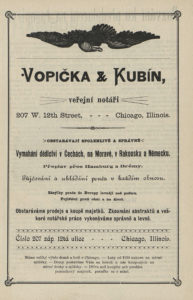 The First National Building, Loan and Homestead Association of Chicago meets weekly in the office of Vopicka & Kubin. This Association was incorporated in the spring of 1883 under an act of the legislature of Illinois, which went into force July 1, 1879, and which was passed to enable associations of persons to become bodies corporate, and to raise fund to lend only to their members. The first officers of this Association were, Jan Geringer, president; Jan Zasadil, vice-president; Josef Roubik, treasurer; Otto Kubin, secretary; Fred. Novy and R.J. Schlesinger, assistant secretaries. The first directors were, for one year, Martin Hejduk, Vaclav Mlejnek, and Albert Klimes; for two years, Joseph Base, Charles J. Vopicka and Charles Foucek; for three years, Ludvik Zavaell, Ferdinand Kubicek and Josef Pugner, Each share of stock in this company is $100, and members are permitted to become members and share holders by paying twenty five cents per week on each share held. It was through the existence of this and similar associations that Vopicka & Kubin have been enabled to make such extensive sales. The Second national Building, Loan and Homestead Association was organized in April, 1884; Charles J. Vopicka, president; Josef Roubik, vice president; Otto Kubin, sectreatry, and Albert Silhanek, treasurer. The purposes of the Association are similar to those of its predecessor. (4) The Paul Nemecek article lists that by 1912 there were 106 Czech building and loan associations out of a total of 227 in all of Chicago. (7)
The First National Building, Loan and Homestead Association of Chicago meets weekly in the office of Vopicka & Kubin. This Association was incorporated in the spring of 1883 under an act of the legislature of Illinois, which went into force July 1, 1879, and which was passed to enable associations of persons to become bodies corporate, and to raise fund to lend only to their members. The first officers of this Association were, Jan Geringer, president; Jan Zasadil, vice-president; Josef Roubik, treasurer; Otto Kubin, secretary; Fred. Novy and R.J. Schlesinger, assistant secretaries. The first directors were, for one year, Martin Hejduk, Vaclav Mlejnek, and Albert Klimes; for two years, Joseph Base, Charles J. Vopicka and Charles Foucek; for three years, Ludvik Zavaell, Ferdinand Kubicek and Josef Pugner, Each share of stock in this company is $100, and members are permitted to become members and share holders by paying twenty five cents per week on each share held. It was through the existence of this and similar associations that Vopicka & Kubin have been enabled to make such extensive sales. The Second national Building, Loan and Homestead Association was organized in April, 1884; Charles J. Vopicka, president; Josef Roubik, vice president; Otto Kubin, sectreatry, and Albert Silhanek, treasurer. The purposes of the Association are similar to those of its predecessor. (4) The Paul Nemecek article lists that by 1912 there were 106 Czech building and loan associations out of a total of 227 in all of Chicago. (7)
Chicago banks owned and operated by Bohemians
Several publications give credit to William Kaspar as the founder of the first Bohemian owned and operated bank.
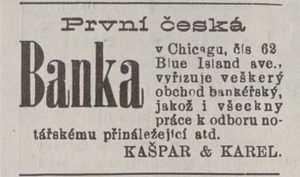 “It was in August, 1864, that William Kaspar took up his permanent abode in Chicago, Illinois, where he engaged in the grocery and bakery business until the great conflagration of 1871, after which he began real estate operations as a member of the firm of Novak and Kaspar. Following the dissolution of this partnership William Kaspar continued in business alone until 1888, when he organized a private bank under the name of Kaspar & Karel. His associate, John Karel, left the firm in 1893 having received appointment as consul at Prague, Bohemia, and Mr. Kaspar thereafter conducted the institution along until 1905, when it was incorporated as the Kaspar State Bank, of which he served as president throughout the remain of his life. In July, 1924, the Kaspar State Bank was consolidated with the American State Bank under the name of the Kaspar American State Bank. William Kaspar was also the organizer and president of the First National Bank of Cicero and enjoyed an enviable reputation as a financier of marked ability and keen sagacity. (7) Image (7b)
“It was in August, 1864, that William Kaspar took up his permanent abode in Chicago, Illinois, where he engaged in the grocery and bakery business until the great conflagration of 1871, after which he began real estate operations as a member of the firm of Novak and Kaspar. Following the dissolution of this partnership William Kaspar continued in business alone until 1888, when he organized a private bank under the name of Kaspar & Karel. His associate, John Karel, left the firm in 1893 having received appointment as consul at Prague, Bohemia, and Mr. Kaspar thereafter conducted the institution along until 1905, when it was incorporated as the Kaspar State Bank, of which he served as president throughout the remain of his life. In July, 1924, the Kaspar State Bank was consolidated with the American State Bank under the name of the Kaspar American State Bank. William Kaspar was also the organizer and president of the First National Bank of Cicero and enjoyed an enviable reputation as a financier of marked ability and keen sagacity. (7) Image (7b)
One person who could use a closer look is J. B.  Belohradsky, not from his success, (which newspaper articles suggest the opposite) but rather as perhaps establishing an early Bohemian bank. His 1880 Chicago census record (Illinois, Cook, Chicago, 054, Page 14 at 206 west 20th street) lists him as a Bohemian, with the occupation of Notary. Ads, found as early as 1878, list him as a notary and several ads in 1883 include “Banka”. That said, most newspaper clippings in the 1880’s describe Belohradsky as the center of many financial problems and investigations.
Belohradsky, not from his success, (which newspaper articles suggest the opposite) but rather as perhaps establishing an early Bohemian bank. His 1880 Chicago census record (Illinois, Cook, Chicago, 054, Page 14 at 206 west 20th street) lists him as a Bohemian, with the occupation of Notary. Ads, found as early as 1878, list him as a notary and several ads in 1883 include “Banka”. That said, most newspaper clippings in the 1880’s describe Belohradsky as the center of many financial problems and investigations.
Thomas Capek and his son, Thomas, wrote in 1920 that Illinois had, at that time, ten banks, all in Chicago, which were Czech or Slovak controlled through stock ownership. (8)
They were:
Twenty Sixth Street Bank (1893) President - John Zelezny
Skala State Bank (1896) President – Frank Skala
Kaspar State Bank (1905) President – William Kaspar
Lawndale National Bank (1911) President – Frank Hajicek
American State Bank (1911) President – James Stepina
Lawndale State Bank (1912) President – Joseph Salat
Western Bank of Cicero (1913) President – Frank Kirchman
Douglas Park State Bank (1919) President – Frank Kirchman
First National Bank of Cicero (1920) President – William Kaspar (8)
Image (8b)
Images Below: Left to Right: 8c, 8d, 8e
Bohemians migrate westward - Bohemian Banks Develop in Lawndale - "Ceske California"
Denni Hlasatel - October 27, 1912 (Foreign Language Press Survey)
The live business artery of our Bohemian "California," 26th Street, will soon be enriched by a new building which will demonstrate Bohemian astuteness in the banking business. It will be the splendid building of the first Bohemian national bank in Chicago, located at 3337-39 West 26th Street, between Homan and Turner Avenues, right in the heart of the largest colony of Chicago Bohemians. It will carry the name "Lawndale National Bank Building". It will cost $50,000 and, when finished, will be one of the most beautiful, most modern, and best equipped bank buildings on Chicago's West Side.....Its stone front with bronze ornamentation.....will be a masterpiece of architecture. The main hall is 45 by 100 feet, 21 feet high, and contains two safes 18 by 22 feet square and two stories high.....The building activities will start tomorrow.
The Lawndale National Bank, which is the first Bohemian national bank in Chicago, was formed by the recent merger of two Bohemian banking houses, that of Salát, Polák, and Kopecký, and Mr. Frank G. Hájíček's bank (9)
Denni Hlasatel - January 2, 1921 - "Tremendous Growth of the Lawndale State and Lawndale National Banks" - (Foreign Language Press Survey)
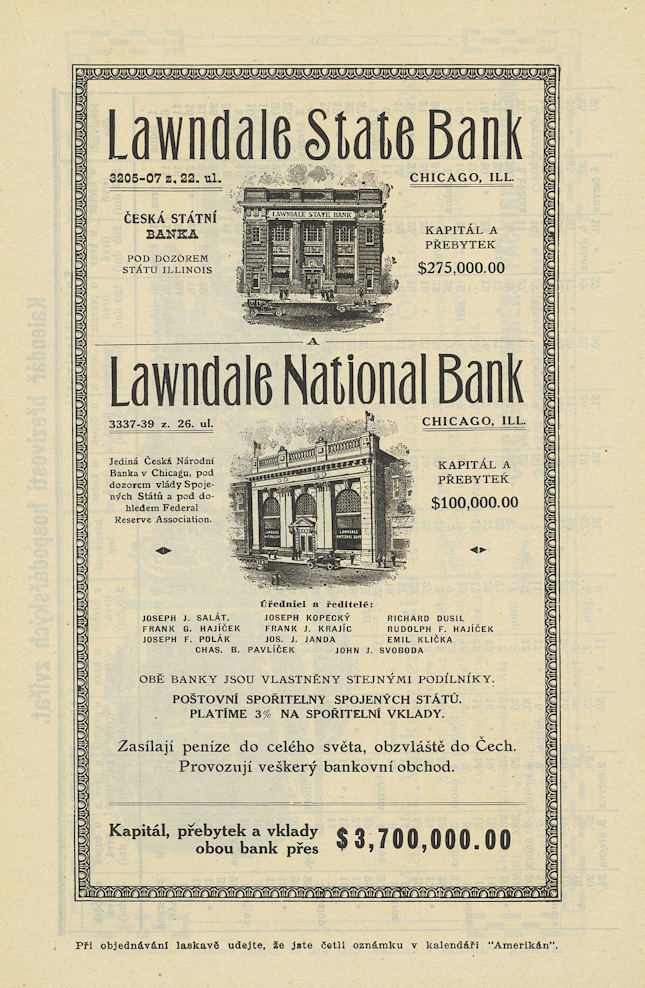 Those who have had an opportunity to follow the activities of the Lawndale State Bank and the Lawndale National Bank during the past years will gladly and proudly admit that the growth of the above-mentioned banking institutions, attained through their own efforts from small beginnings, has been spectacular. The Lawndale State Bank originated from a company doing business under the name Salat, Polák, and Kopecký, founded fifteen years ago. The year following, Mr. Frank G. Hajíček established a banking department in his place of business. The real foundations for the Lawndale State Bank were laid on January 1, 1912. In the same year, during the month of September, the Lawndale National Bank was established. Therefore, the success attained by both of these really Bohemian banks of Česka Kalifornie (Bohemian California) during such a short period is not only remarkable, but also extremely great.
Those who have had an opportunity to follow the activities of the Lawndale State Bank and the Lawndale National Bank during the past years will gladly and proudly admit that the growth of the above-mentioned banking institutions, attained through their own efforts from small beginnings, has been spectacular. The Lawndale State Bank originated from a company doing business under the name Salat, Polák, and Kopecký, founded fifteen years ago. The year following, Mr. Frank G. Hajíček established a banking department in his place of business. The real foundations for the Lawndale State Bank were laid on January 1, 1912. In the same year, during the month of September, the Lawndale National Bank was established. Therefore, the success attained by both of these really Bohemian banks of Česka Kalifornie (Bohemian California) during such a short period is not only remarkable, but also extremely great.
Credit for this rapid growth must be awarded first to the managers, consisting of conscientious and experienced men, and then to the employees who, through their accuracy, honesty, and obligingness, gained a great number of new customers for both banking institutions. Besides that, both of these banks gained favor with our people because their managers always stood at the head of our national and philanthropic activities, generously supporting every good cause.
It is not surprising, then, that both of these institutions have grown so rapidly. Today, both banks are the foremost banking institutions of Česká Kalifornie, and from the records of the American banking statistics, it is apparent that both banks are included in the list of banks of the United States, and occupy second place in the amount of deposits in relation to the capital.....
Both banks started out with deposits representing the sum of $1,200,000. Today, the deposits represent the sum of more than $9,000,000. Because of this ever-increasing growth, both of these banking institutions decided to increase their capital to $500,000 each, beginning tomorrow, January 3, 1921. Today, the resources of both banks represent the awe-inspiring sum of ten million dollars. This sum, then, is the best recommendation for the Lawndale State and Lawndale National Banks; it is also the security for accurate and honest service, guaranteed by both of these banking institutions in any financial and real-estate matters. (10), Image (10a)
Denni Hlasatel - January 7, 1912 - "A New Bank in Bohemian California" - (Foreign Language Press Survey)
Chicago Czechs are progressing satisfactorily in every sphere of endeavor, and Czech banks can be classed among the best managed and most successful. This group of banks has just been enlarged by a new one, which bears the name, "Southwest Savings Bank", The proprietors are two young, but tried and proved countrymen. They are Messrs. Louis J. Krejčí and Joseph J. Kroupa. Mr. Krejčí, up to the present time, had a prosperous real-estate business on the premises which the bank is taking over, by which he gained many business and personal friends. Mr. Kroupa is a capable lawyer and gained much valuable banking experience in his long association with the oldest Czech banking institution. [The Kaspar State Bank.] Both young bankers were born in Chicago, enjoy general popularity and confidence, and it is quite certain that their banking business will flourish and grow. Everyone who turns to them will be served quickly, accurately, and honestly. In the savings department, deposits of one dollar or more are accepted and interest is paid at the rate of three per cent.
The real-estate business will be continued. Loans will be made with the most advantageous conditions; mortgages and insurance will be sold--in fact they will handle all transactions of this nature. (11)
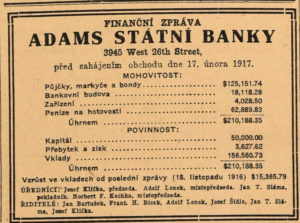 Denni Hlasatel - December 25, 1914 - "A New Bohemian State Bank" - (Foreign Language Press Survey)
Denni Hlasatel - December 25, 1914 - "A New Bohemian State Bank" - (Foreign Language Press Survey)
Mr. Josef Klicka and Mr. Jan F. Slama, the noted Bohemian bankers who operate the Tabor Savings Bank at 3945 West 26th Street, have established a new bank at the same location--the Adams State Bank. (12) Image (12a)
Bohemian Banks Also Locate To The Southwest Side
Osadne Hlasy Newspaper - April 3, 1931 - Amalgamation of Two Leading Southwest Side Banks - (Foreign Language Press Survey)
We have just been informed of the amalgamation of  two leading banks; the Southwest State Bank and the Depositors State Bank. The two banks will be united under the name of Depositors State Bank, which will be located at the latter's present address, 4701 So. Ashland Avenue.
two leading banks; the Southwest State Bank and the Depositors State Bank. The two banks will be united under the name of Depositors State Bank, which will be located at the latter's present address, 4701 So. Ashland Avenue.
The Depositors State Bank is one of the soundest banks on the Southwest side. Its present resources are $8,000,000, with 21,000 depositors. Through this consolidation, an institution has been created which will be able to serve its patrons better than the smaller banks.
There will be no change in the staff. Mr. Julius F. Smietanka, well-known Slovak banker and lawyer, is chairman of the board of directors; Mr. John S. Jurik, one of the leading Czecho-Slovak bankers of Chicago, is vice chairman; Robert D. Mathias, under whose untiring efforts and leadership the bank has grown, is president; Mr. George D. Hopkins is chairman of the executive board; Mr. A. J. Calek, former vice-president of the Southwest State Bank, and one of the best known Czecho-Slovak bankers of Chicago, was made vice-president; Thomas E. Wilson, president of Wilson & Co., is president of the advisory board; Mr. A. M. Smietanka is vice-president and member of the board of trustees; Mr. Stanley J. Ratajczak, who has been connected with the bank since its foundation, is vice-president and treasurer; and A. Tupy is assistant treasurer. The firm of Smietanka, Poulton, and Bryant took care of legal matters for the Depositors State Bank. (Note: Additional newspaper articles seem to indicate this bank closed during the Great Depression.) (13) Image (13a)
Bohemian Migration Continues Westward - Downtown Bohemia - The Bohemian Wall Street
The earliest most mentioned Bohemian community was “Praha”, just west of downtown. Then came “Pilsen”, with additional Bohemians arriving to Chicago, along 18th Street, and Blue Island. By the 1880s Bohemians were moving to the South Lawndale and adjacent lands. It was “Ceske California”. The notaries and mortgage lenders were changing into Bohemian Banking and Loan Associations and then the first banks. The giant Western Electric Hawthorne works and other circumstances lured the Bohemians further westward. By the 1940’s it was Berwyn and Cicero. The Bohemian financial institutions followed and multiplied.
Dr. Irving Cutler, in his book, described that by 1930 “over one third of the combined population of Cicero and Berwyn was of Czechoslovak descent, and that today (1982) they contain the greatest concentration of Czechs in the metropolitan area.” (14)
Czech restaurants, organizations, and numerous related businesses filled the two suburbs. 22nd Street (already named Cermak) was the main commercial artery running through both suburbs. If it was shopping, it was “Downtown Bohemia”. If it was real estate, and banking, it was the “Bohemian Wall Street”.
Denni Hlasatel - December 14, 1922 - "New Czech Bank Opens in Berwyn" - (Foreign Language Press Survey)
Proof of the growth and development of any community is the establishment of banking institutions within it. Therefore, the recent organization of a new Czech banking institution in Berwyn, Illinois, furnishes such proof. It is quite an event for our community. The Czechoslovak banking system has won for itself undoubted prestige, for wherever a Czech settlement is founded, there also, sooner or later, a Czech bank is established. This is the result of the thrift and effort of our people.
The Berwyn community is one of our most promising Czech settlements; and here a new Czech bank will open its doors next Saturday. Its name will be the Berwyn Trust and Savings Bank. Among the board of directors are the following: Messrs. Louis Stastny, J. A. Vasumpaur, M.D., and John Krivanek.
These names are a guarantee that every one of our countrymen will be honestly and efficiently served by this new bank, and we hope that this new Czechoslovak enterprise will find favor with all of our public. The bank is located on Oak Park Avenue, near the Chicago, Burlington, and Quincy Railroad. (15)
3
Little Round Donut Holes and Coffee – Memories of Talman Bank
 This writer remembers Talman Federal Savings and Loan. This writer remembers having a bunch of those little donut holes and a cup of coffee at Talman’s. High school friends worked at Talman’s.
This writer remembers Talman Federal Savings and Loan. This writer remembers having a bunch of those little donut holes and a cup of coffee at Talman’s. High school friends worked at Talman’s.
In 1980 Talman Federal Savings and Loan Association merged with Home Federal Savings and Loan Association. On December 14, 1980, the Chicago Tribune published a really good article on the story of both banks. Both were founded by Bohemians.
In 1922, on 51st Street, close to Talman Avenue, Ben Bohac founded Talman. The company worked out of his home for several years. An advertisement for Bohac’s bank appeared in 1922. Newspaper advertisements of the 1920’s though are mostly dealing with real estate, the selling of properties listing Ben Bohac and his home and office address of 2641 W. 51st Street. The first newspaper advertisement found so far listing Talman Federal is in the Southtown Economist on July 24, 1938, Page 26.
The Tribune credits the establishment of Home Federal Savings and Loan to John L. Novak in 1886. Early business activities were conducted in the Kanizl tavern, 1820 North Racine. The Inter Ocean newspaper of Chicago, on October 31, 1886 listed the incorporation of the Pokrok Building, Loan and Homestead Association, naming a John Novak in that incorporation notice.(13)
Much of the same story is repeated in a Chicago Tribune Article on Talman when Talman was taken over by La Salle Bank. (14)
Image (15)
.
References:
1. “Czechs and Slovaks in Early Chicago Banking” – Paul Nemecek, KORENY – Journal of the Czech and Slovak American Genealogy Society of Illinois, Fall 2002, Sugar Grove, Illinois, Page 1.
2. “The Czechs and Slovaks in American Banking” – Thomas Capek and Thomas Capek Jr., Fleming H. Revell Publishing Company, 1920, Page 7
2a. Advertisement Amerikan Kalendar, August Geringer Publisher, Chicago, Illinois, 1879.
2b. Ibid, 1884.
3. “Czechs and Slovaks in Early Chicago Banking” – Paul Nemecek, KORENY – Journal of the Czech and Slovak American Genealogy Society of Illinois, Fall 2002, Sugar Grove, Illinois, Page 1.
4. Chicago Building Societies Which Represent an Investment of $5,000,000
The Bohemians the Pioneers, Chicago Tribune Newspaper, March 15, 1883, Page 23.
4a. 4b Advertisement Amerikan Kalendar, August Geringer Publisher, Chicago, Illinois, 1884.
5. "The Loan Association and Their Pioneers - The Bohemians" - Svornost, March 27, 1883, https://flps.newberry.org/#/- Foreign Language Press Survey Web Site - Newberry Library, Chicago, Illinois.
5a. Advertisement Amerikan Kalendar, August Geringer Publisher, Chicago, Illinois, 1884.
6. Summary - Denní Hlasatel, Oct. 28, 1913 - https://flps.newberry.org/#/- Foreign Language Press Survey Web Site - Newberry Library, Chicago, Illinois,
7. “A History of Chicago”, A.T. Andreas, The A.T. Andreas Company Publishers, Chicago, Illinois, 1886, Page 186.
7b. Image Kaspar and Karel - Duch Casu - Foreign Language newspaper - Chicago, Illinois, February 3, 1889, Page 4
8. “The Czechs and Slovaks in American Banking” – Thomas Capek and Thomas Capek Jr., Fleming H. Revell Publishing Company, 1920, Page 7
8b. Advertisement Amerikan Kalendar, August Geringer Publisher, Chicago, Illinois, 1883.
8c. Ibid, 1912
8d. Ibid 1911
8e. Advertisement Denni Hlasatel, foreign language newspaper, Chicago, Illinois, February 22, 1917, Page 3.
9. Denni Hlasatel - October 27, 1912 - https://flps.newberry.org/#/- Foreign Language Press Survey Web Site - Newberry Library, Chicago, Illinois.
10. "Tremendous Growth of the Lawndale State and Lawndale National Banks" - Denni Hlasatel - January 2, 1921 - https://flps.newberry.org/#/- Foreign Language Press Survey Web Site - Newberry Library, Chicago, Illinois.
10b. Advertisement Amerikan Kalendar, August Geringer Publisher, Chicago, Illinois, 1923.
11. "A New Bank in Bohemian California" - Denni Hlasatel - January 7, 1912 - https://flps.newberry.org/#/- Foreign Language Press Survey Web Site - Newberry Library, Chicago, Illinois.
12. "A New Bohemian State Bank" - Denni Hlasatel, December 25, 1914 - https://flps.newberry.org/#/- Foreign Language Press Survey Web Site - Newberry Library, Chicago, Illinois.
12b. Advertisement Denni Hlasatel, foreign language newspaper, Chicago, Illinois, February 22, 1917, Page 3.
13. “Talman aims for top in merger with Home” – The Chicago Tribune newspaper, Chicago, Illinois, December 14, 1980, Pages 93-94.
14. “LaSalle’s Owner to buy Talman” – “Old World values built Talman” - The Chicago Tribune newspaper, Chicago, Illinois, July 16, 1991, Pages 1 and 10.
15. Advertisement - Dragus, Lithuanian Newspaper, Chicago, illinois, February 17, 1922, Page 3.

